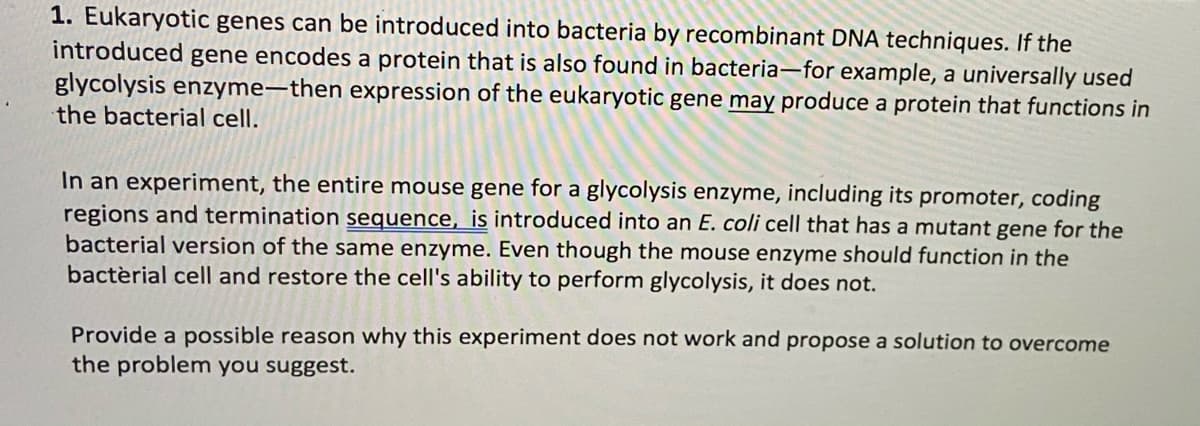. Eukaryotic genes can be introduced into bacteria by recombinant DNA techniques. If the ntroduced gene encodes a protein that glycolysis enzyme–then expression of the eukaryotic gene may produce a protein that functions in Ehe bacterial cell. also found in bacteria-for example, a universally used In an experiment, the entire mouse gene for a glycolysis enzyme, including its promoter, coding regions and termination sequence, is introduced into an E. coli cell that has a mutant gono for th
. Eukaryotic genes can be introduced into bacteria by recombinant DNA techniques. If the ntroduced gene encodes a protein that glycolysis enzyme–then expression of the eukaryotic gene may produce a protein that functions in Ehe bacterial cell. also found in bacteria-for example, a universally used In an experiment, the entire mouse gene for a glycolysis enzyme, including its promoter, coding regions and termination sequence, is introduced into an E. coli cell that has a mutant gono for th
Biology: The Dynamic Science (MindTap Course List)
4th Edition
ISBN:9781305389892
Author:Peter J. Russell, Paul E. Hertz, Beverly McMillan
Publisher:Peter J. Russell, Paul E. Hertz, Beverly McMillan
Chapter19: Genomes And Proteomes
Section: Chapter Questions
Problem 8TYK
Related questions
Question
100%
Bio question

Transcribed Image Text:1. Eukaryotic genes can be introduced into bacteria by recombinant DNA techniques. If the
introduced gene encodes a protein that is also found in bacteria-for example, a universally used
glycolysis enzyme–then expression of the eukaryotic gene may produce a protein that functions in
the bacterial cell.
In an experiment, the entire mouse gene for a glycolysis enzyme, including its promoter, coding
regions and termination sequence, is introduced into an E. coli cell that has a mutant gene for the
bacterial version of the same enzyme. Even though the mouse enzyme should function in the
bactèrial cell and restore the cell's ability to perform glycolysis, it does not.
Provide a possible reason why this experiment does not work and propose a solution to overcome
the problem you suggest.
Expert Solution
This question has been solved!
Explore an expertly crafted, step-by-step solution for a thorough understanding of key concepts.
This is a popular solution!
Trending now
This is a popular solution!
Step by step
Solved in 2 steps

Knowledge Booster
Learn more about
Need a deep-dive on the concept behind this application? Look no further. Learn more about this topic, biology and related others by exploring similar questions and additional content below.Recommended textbooks for you

Biology: The Dynamic Science (MindTap Course List)
Biology
ISBN:
9781305389892
Author:
Peter J. Russell, Paul E. Hertz, Beverly McMillan
Publisher:
Cengage Learning

Biology: The Dynamic Science (MindTap Course List)
Biology
ISBN:
9781305389892
Author:
Peter J. Russell, Paul E. Hertz, Beverly McMillan
Publisher:
Cengage Learning